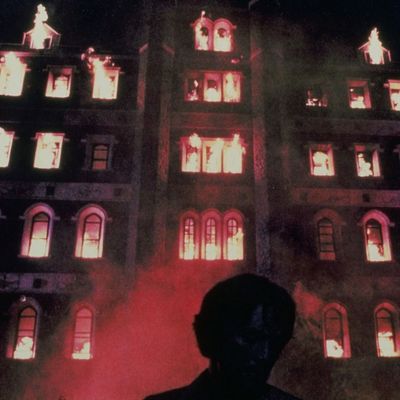
So you’re about to see the new Suspiria, a remake of the Dario Argento classic from 1977 by director Luca Guadagnino. The setting is the Helena Markos Dance Company in Berlin, and the subject is Susie Bannion (Dakota Johnson), a young woman who arrives there and quickly becomes a point of interest for the coven of witches that run it. In the original film, that information is saved until later in the story, but the new Suspiria pretty much opens with it. The trailer for the film even teases the great force hovering over and above and inside the Markos Company, as we see in a frantic journal entry that reads: “Bigger than everything and more important. The three mothers that have always been there.” As we look at the page, Dr. Josef Klemperer (Tilda Swinton as Lutz Ebersdorf) lists off the names, “Three Mothers, three gods, three devils. Mother Tenebrarum, Mother Lachrymarum, and Mother Suspiriorum. Darkness, tears, and sighs.”
If you’re not a way-back Suspiria fan, you might not know that it’s the first in a string of films called the Three Mothers Trilogy directed by Argento. The second two are Inferno from 1980 and The Mother of Tears from 2007, and the filmmaker based his concept for the movies on an excerpt from the book Suspiria De Profundis by Thomas De Quincey. In an essay called “Levana and Our Ladies of Sorrow” De Quincey wrote, “I want a term expressing the mighty abstractions that incarnate themselves in all individual sufferings of man’s heart; and I wish to have these abstractions presented as impersonations, that is, as clothed with human attributes of life, and with functions pointing to flesh. Let us call them, therefore, Our Ladies of Sorrow.”
These ladies — called Mother Tenebrarum, Mother Lachrymarum, and Mother Suspiriorum — became Argento’s Three Mothers, and they are the foundation for each the films in his trilogy. Suspiria, as the title suggests, concerns the third name in that order. But to get the fullest understanding of who these elusive and extremely powerful witches are, it’s most helpful to start with Inferno.
Mater Tenebrarum, Our Lady of Darkness
What did De Quincey say?
“She is the defier of God. She also is the mother of lunacies, and the suggestress of suicides. Deep lie the roots of her power; but narrow is the nation that she rules. For she can approach only those in whom a profound nature has been upheaved by central convulsions; in whom the heart trembles and the brain rocks under conspiracies of tempest from without and tempest from within.”
What did Argento do?
Inferno opens with a prologue that puts the entire Trilogy in context. A voice-over reads a passage from a book called The Three Mothers by an architect and alchemist named E. Varelli, and it gives us a good 30,000-foot view:
“I don’t know what price I shall have to pay for breaking what we alchemists call Silentium. The life experience of our colleague should teach us not to upset laymen by imposing our knowledge upon them. I, Varelli, an architect living in London, met the Three Mothers and designed and built for them three dwelling places. One in Rome, one in New York, and a third in Freiburg, Germany. I failed to discover until too late that from those three locations the Three Mothers rule the world with sorrow, tears, and darkness. Mater Suspiriorum, the Mother of Sighs and the oldest of the three, lives in Freiburg. Mater Lachrymarum, the Mother of Tears and the most beautiful of the sisters, holds rule in Rome. Mater Tenebrarum, the Mother of Darkness, who is the youngest and cruelest of the three, controls New York. And I built their horrible houses — the repositories of all their filthy secrets. Those so-called mothers are actually wicked stepmothers, incapable of creating life.”
Suspiria is the most famous, but Inferno is arguably the most beautiful of the three, and Argento’s contemporary Mario Bava, the giallo icon, helped with some of the visuals for the film. It’s set in the New York faction of the Three Mothers empire, and takes place in the building where Tenebrarum lives. She is the youngest and cruelest of the three, which makes sense with the whole “suggestress of suicides” bit, and Inferno even features a cameo by one of her sisters in witchcraft, Mater Lachrymarum. So let’s jump to the end and talk about her next.
Mater Lachrymarum, Our Lady of Tears
What did De Quincey say?
“She it is that night and day raves and moans, calling for vanished faces.”
What did Argento do?
The strongest and most beautiful of the Mothers was featured in Mother of Tears, which starred Dario’s daughter, Asia Argento, as the descendant of a white witch who fought against and weakened Mater Suspiriorum to “a shell of her former self” prior to the events of Suspiria. (Suspiriorum’s depleted state is an important element of original film, and also a key component of the remake.) The Mothers’ ability to influence the world around them is displayed most prominently here, with violence spreading across Rome as Lachrymarum, the mightiest of the witches, grows more powerful.
In Suspiria de Profundis she is the oldest of the trio, but in Tears she is the middle one, and this movie also gives some details on the origin story of the witches when Udo Kier’s Father Johannes explains, “More than a thousand years ago witchcraft was birthed by the shores of the Black Sea by three sisters. For years they roamed the Earth bringing death and destruction wherever they went.” So in the parlance of our times, they’re kind of like three Supremes. And now we arrive at our current concern, Mater Suspiriorum.
Mater Suspiriorum, Our Lady of Sighs
What did De Quincey say?
“Her eyes, if they were ever seen, would be neither sweet nor subtle; no man could read their story; they would be found filled with perishing dreams, and with wrecks of forgotten delirium.”
What did Argento do?
De Quincey’s idea of Mater Suspiriorum was definitely a more charitable one than Argento’s, but “delirium” and “perishing dreams” does line up. As Alexander H. Japp wrote in his edited collection of De Quincey’s work, “The master-idea of the Suspiria is the power which lies in suffering, in agony unuttered and unutterable, to develop the intellect and the spirit of man; to open these to the ineffable conceptions of the infinite, and to some discernment, otherwise impossible, of the beneficent might that lies in pain and sorrow.” And that sounds a lot more like what is going on at the Helena Markos Dance Company, where there is a hell of a lot of unuttered agony, suffering, and “beneficent might” that the coven would have you believe “lies in pain and sorrow.” Profundis described Suspiriorum as the second Mother, but in Argento’s trilogy she is the oldest and wisest of the witches.
And what about Mother Markos?
Helena Markos is present in the 1977 film as well as the new one, but we won’t say any more on that, because the story has varied in some key ways. But for backstory purposes: In the original film she was a Greek immigrant who founded the Tanz Akademie in Freiburg, Germany, in 1895, and eventually faked her own death to throw off suspicion that she might be a witch. She of course maintained control of it in secret, and in both the new and remade versions, exists as a kind of shadow leader of the coven. In that peek at a journal we get in the new Suspiria trailer, we also see this written down: “Today there is only her, one of them and at the same time not … Mother Markos, a shadow over my story.” Guess you’ll have to go see the new movie to find out what that means!


